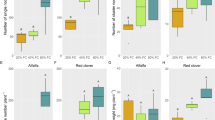Abstract
Uptake kinetics of arsenate were determined in arsenate tolerant and non-tolerant clones of the grassDeschampsia cespitosa under differing root phosphorus status to investigate the mechanism controlling the suppression of arsenate influx observed in tolerant clones. Influx was always lower in tolerants compared to non-tolerants. Short term influx of arsenate by the high affinity uptake system in both tolerant clones was relatively insensitive to root phosphorus status. This was in contrast to the literature where the regulation of the phosphate (arsenate) uptake system is normally much more responsive to plant phosphorus status. The low affinity uptake system in both tolerant and non-tolerant clones, unlike the high affinity uptake system, was more closely regulated by root phosphate status and was repressed to a much greater degree under increasing root phosphorus levels than the high affinity system.
Similar content being viewed by others
References
Allen S E 1974 Chemical analysis of Ecological Materials. Blackwell, Oxford.
Asher C J and Reay P F 1979 Arsenic uptake by barley seedlings. Aust. J. Plant Physiol. 6, 459–466.
Beever R E and Burns D W J 1980 Phosphorus uptake storage and utilization by fungi. Adv. Bot. Res. 8,127–219.
Brown T A and Schrift A 1982 Selenium: toxicity and tolerance in higher plants. Biol. Abst. 57, 59–84.
Chapin F S 1980. The mineral nutrition of wild plants. Ann. Rev. Ecol. System. 11, 233–260.
Clarkson D T and Lüttge U 1989 Mineral nutrition: divalent cations, transport and compartmentation. Prog. Bot. 51, 93–112.
Clarkson D T and Lüttge U 1991 Mineral nutrition: Inducible and repressible nutrient transport systems. Prog. Bot. 52, 93–112.
Clarkson D T and Scattergood C B 1982 Growth and phosphate transport in barley and tomato plants during the development of, and recovery from, phosphate-stress. J. Exp. Bot. 33, 865–875.
Cogliatti D H and Clarkson D T 1983 Physiological changes in, and phosphate uptake by potato plants during development of, and recovery from phosphate deficiency. Physiol. Plant. 58, 287–294.
De Vos C H R, Vonk M J, Vooijs R and Schat H 1992. Glutathione depletion due to copper induced phytochelatin synthesis causes oxidative damage inSilene cucubalus. Plant Physiol. 98, 853–858.
Epstein E 1976. Kinetics of ion transport and the carrier concept. In Transport in Plants II. Part B, Tissues and Organs, Encyclopedia of Plant Physiology. Eds. U Lüttge and M G Pitmann, pp 70–94. Springer-Verlag, Berlin.
Huang J H, Shaff J E, Grunes D L and Kochian L V 1992. Aluminum effects on calcium fluxes at the root apex of aluminum-tolerant and aluminum-sensitive wheat cultivars. Plant Physiol. 98, 230–237.
Lee R B 1982. Selectivity of kinetics of ion uptake by barley plants following nutrient deficiency. Ann. Bot. 50, 429–449.
Lefebvre D and Glass D M 1982 Regulation of phosphate influx in barley roots: Effects of phosphate deprivation and reduction of influx with provision of orthophosphate. Physiol. Plant. 54, 199–206.
McPharlin I R and Bieleski R L 1987 Phosphate uptake bySpirodela andLemna during early stages of phosphate deficiency. Aust. J. Plant Physiol. 14, 561–572.
Marquardt D W 1963 An algorithm for least-squares estimation of nonlinear parameters. J. Soc. Indust. Appl. Math. 11, 431–441.
Meharg A A and Macnair M R 1990. An altered phosphate uptake system in arsenate tolerantHolcus lanatus. New Phytol. 116, 29–35.
Meharg A A and Macnair M R 1991a Uptake, accumulation and translocation in arsenate tolerant and non-tolerantHolcus lanatus L. New Phytol. 117, 225–231.
Meharg A A and Macnair M R 1991b The mechanisms of arsenate tolerance inDeschampsia cespitosa L. andAgrostis capillaris L.: Adaptation of the arsenate uptake system. New Phytol. 119, 291–297.
Meharg A A and Macnair M R 1992a Suppression of the high affinity phosphate uptake system: a mechanism of arsenate tolerance inHolcus lanatus L.. J. Exp. Bot. 43, 519–524.
Meharg A A and Macnair M R 1992b Polymorphism physiology of arsenate tolerance inHolcus lanatus L. from an uncontaminated site. Plant and Soil 146, 219–225.
Meharg A A and Macnair M R 1993 Phosphorus nutrition of arsenate tolerant and non-tolerantHolcus lanatus L. (Poaceae) growing on arsenic contaminated and uncontaminated sites. J. Environ. Qual. (In press).
Silver S and Misra T K 1988 Plasmid-mediated heavy metal resistances. Annu. Rev. Microbiol. 42, 717–743.
Verkleij J A C and Schat H 1990 Mechanisms of metal tolerance in plants.In Heavy Metal Tolerance in Plants: Evolutionary Aspects. Ed. A J Y Shaw. pp 179–193, CRC Press, Florida.
Author information
Authors and Affiliations
Rights and permissions
About this article
Cite this article
Meharg, A.A., Macnair, M.R. Relationship between plant phosphorus status and the kinetics of arsenate influx in clones ofdeschampsia cespitosa (L.) beauv. that differ in their tolerance to arsenate. Plant Soil 162, 99–106 (1994). https://doi.org/10.1007/BF01416094
Received:
Accepted:
Issue Date:
DOI: https://doi.org/10.1007/BF01416094




